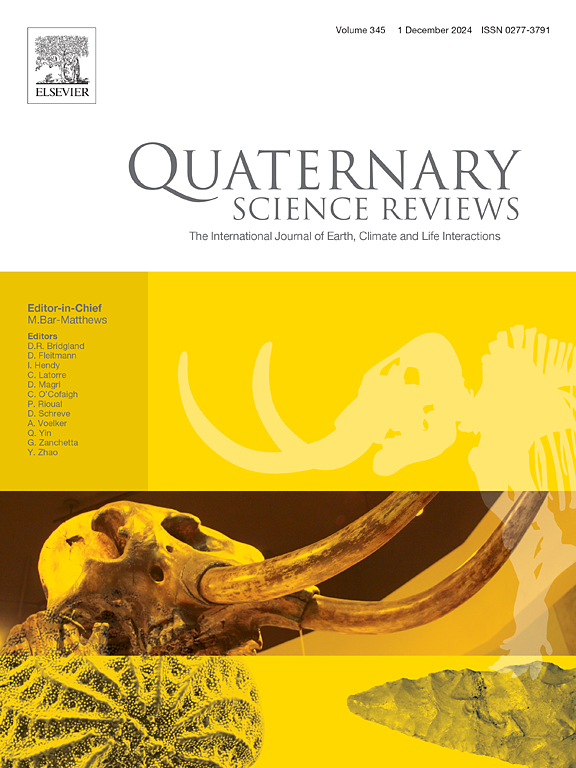巴伐利亚 Schliersee 新世晚期的古水文学和人类驱动的古生产率
IF 3.2
1区 地球科学
Q1 GEOGRAPHY, PHYSICAL
引用次数: 0
摘要
由于阿尔卑斯山北部和南部在空间和时间上的差异,了解欧洲阿尔卑斯山全新世的水文气候多变性具有挑战性。此外,罗马和中世纪时期人类的定居活动加剧了土壤侵蚀和湖泊富营养化,使得从古水文学角度解释湖泊沉积物记录变得更加复杂。在这里,我们展示了巴伐利亚州 Schliersee 长达 ∼4440 年的沉积物记录,并应用叶蜡、地球化学和硅藻分析的特定化合物 δ2H 重建水文和湖泊生产力。陆地δ2Hn-C31记录了降水的同位素组成,与阿尔卑斯山南部吉拉湖的叶蜡δ2H和奥地利斯潘纳格尔洞穴的δ18O相似。这提供了证据,表明在千年时间尺度上,与西风位置变化相关的水汽来源变化是对整个地区同位素信号的一种潜在解释。然而,北大西洋涛动作为冬季信号能否解释对夏季敏感的生物标志物 δ2H 记录的变化仍然存在疑问。水生δ2Hn-C25记录了湖水的同位素组成,其与δ2Hn-C31(Δaq-terr)的同位素偏移被用作湖水蒸发的替代物。我们发现,中世纪气候异常时期蒸发量增加,这与树环研究报告的干旱一致,而小冰河时期蒸发量普遍较低,这可能是由于太阳强迫造成的。在罗马时期和中世纪,湖泊的生产力较高,同时土地的使用导致湖泊的养分输入量增加。第二次世界大战后,工业化肥的强化使用和未经处理的废水排放导致了 20 世纪 50 年代的富营养化。尽管这项研究具有重要的古气候意义,但它强调了结合地球化学和生物代用指标组合的多代用指标方法可以对气候-景观相互作用和人类影响进行可靠的重建。本文章由计算机程序翻译,如有差异,请以英文原文为准。
Paleohydrology and human driven paleoproductivity during the Late Holocene from Schliersee, Bavaria
Understanding Holocene hydroclimatic variability in the European Alps is challenging due to spatial and temporal disparities between the northern and southern Alps. In addition, interpreting lake sediment records in terms of paleohydrology is complicated by human presence during Roman and Medieval settlements, which increased soil erosion and lake eutrophication. Here, we present a ∼4440-year long sediment record from Schliersee, Bavaria, where we applied compound-specific δ2H on leaf waxes, geochemical and diatom analyses to reconstruct hydrology and lake productivity. The terrestrial δ2Hn-C31 records the isotopic composition of precipitation and is similar to leaf wax δ2H from Lake Ghirla, southern Alps, and δ18O from Spannagel cave in Austria. This provides evidence that, on millennial time scales, changes in moisture sources associated with shifts in the position of the Westerlies are one potential explanation regarding the isotope signals across the region. However, doubts remain whether the North Atlantic Oscillation as a winter signal can explain variations in summer-sensitive biomarker δ2H records. The aquatic δ2Hn-C25 records the isotopic composition of lake water and its isotopic offset to δ2Hn-C31 (Δaq–terr) is applied as a proxy for lake evaporation. We find increased evaporation during the Medieval Climate Anomaly in line with a drought reported from tree-ring studies, whereas lower evaporation prevailed during the Little Ice Age, likely due to solar forcing. Lake productivity was higher during the Roman period and Middle Ages, concomitant with land use resulting in higher nutrient inputs into the lake. The intensified use of industrial fertilizers and the drainage of untreated wastewater after the Second World War caused eutrophication during the 1950s. Despite its paleoclimatic significance, this study emphasizes that multi-proxy approaches combining assemblages of geochemical and biological proxies allow robust reconstructions of climate–landscape interactions and human impact.
求助全文
通过发布文献求助,成功后即可免费获取论文全文。
去求助
来源期刊

Quaternary Science Reviews
地学-地球科学综合
CiteScore
7.50
自引率
15.00%
发文量
388
审稿时长
3 months
期刊介绍:
Quaternary Science Reviews caters for all aspects of Quaternary science, and includes, for example, geology, geomorphology, geography, archaeology, soil science, palaeobotany, palaeontology, palaeoclimatology and the full range of applicable dating methods. The dividing line between what constitutes the review paper and one which contains new original data is not easy to establish, so QSR also publishes papers with new data especially if these perform a review function. All the Quaternary sciences are changing rapidly and subject to re-evaluation as the pace of discovery quickens; thus the diverse but comprehensive role of Quaternary Science Reviews keeps readers abreast of the wider issues relating to new developments in the field.
 求助内容:
求助内容: 应助结果提醒方式:
应助结果提醒方式:


